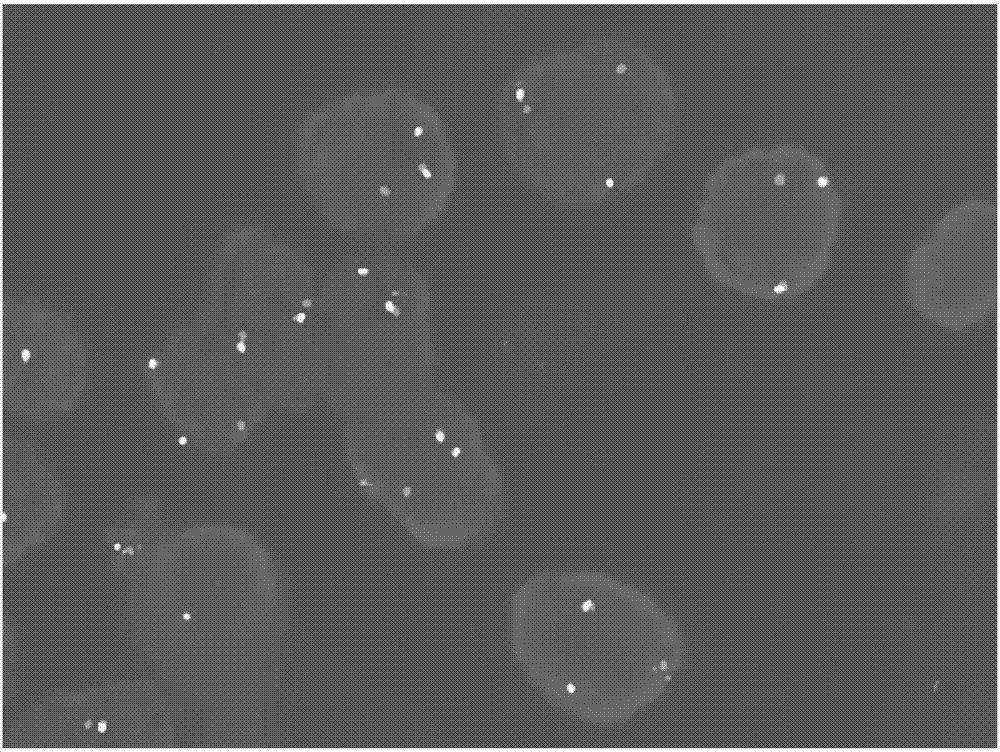Separating probe combination for diagnosing MITF (Microphthalmia-associated Transcription Factor) translocation kidney cancer and application of separating probe combination
A technology for probes and kidney cancer, applied in the field of fluorescent in situ hybridization probes, can solve the problem of not being able to screen out MITF translocation tumors, achieve a reliable success rate, and improve the effect of accuracy
- Summary
- Abstract
- Description
- Claims
- Application Information
AI Technical Summary
Problems solved by technology
Method used
Image
Examples
Embodiment 1
[0035] Embodiment 1: the preparation of DNA probe combination:
[0036] Select two BAC clone fragments that can be connected at both ends of the MITF gene on chromosome 3, control the farthest distance between the probes at both ends within 1500kb, keep a certain distance between the BAC clone fragments without overlapping, and the fragment sizes are similar. The cloned fragments were obtained from the Human BAC Cloning Center of EmpireGenomics (http: / / www.empiregenomics.com / helixhq / clonecentral / search / human). The centromeric BAC clone fragment of MITF was RP11-26P2 (fragment length 163kb), and the BAC clone fragment of MITF telomeric side was RP11-963H1 (fragment length 196kb). The sequence of linkage between the BAC clone fragment and the MITF gene is RP11-26P2, MITF, RP11-963H1. The positioning structure of the probe assembly is as follows figure 1 shown. Use the gap translation method to mark the BAC clone fragment on the telomere side with fluorescence of any color, pr...
Embodiment 2
[0038] Embodiment 2: fluorescence in situ hybridization process:
[0039] A case of MITF translocation renal carcinoma was diagnosed by high-throughput sequencing and RT-PCR detection of fusion genes ( figure 2 , corresponding to the results of this experiment can better reflect the reliability of this experiment), and two experienced pathologists referred to the WHO2016 urinary and male reproductive system classification standards, collected 30 cases of renal cell carcinoma diagnosed in Nanjing General Hospital of Nanjing Military Region as control group.
[0040] Wax blocks were sliced at a thickness of 3 μm. After dewaxing, they were placed in 100%, 85%, and 70% ethanol for 2 minutes each, and then immersed in deionized water for 15 minutes in a water bath at 100°C. Put the tissue slices into pepsin K solution (0.1g pepsin, 40ml 0.01M HCL) at 37°C for 15min; rinse twice with 2×SSC (sodium chloride, sodium citrate) for 5min each, and place the slices in 0.1mol / L Soak in...
PUM
 Login to View More
Login to View More Abstract
Description
Claims
Application Information
 Login to View More
Login to View More - R&D
- Intellectual Property
- Life Sciences
- Materials
- Tech Scout
- Unparalleled Data Quality
- Higher Quality Content
- 60% Fewer Hallucinations
Browse by: Latest US Patents, China's latest patents, Technical Efficacy Thesaurus, Application Domain, Technology Topic, Popular Technical Reports.
© 2025 PatSnap. All rights reserved.Legal|Privacy policy|Modern Slavery Act Transparency Statement|Sitemap|About US| Contact US: help@patsnap.com



